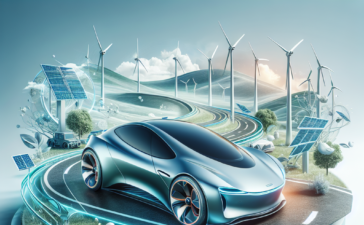Introduction
The automotive industry is undergoing a remarkable transformation, with electric vehicles (EVs) leading the charge towards a greener future. As the demand for EVs continues to surge, it is crucial to understand the key components that make them efficient and sustainable. One such vital element is electric vehicle castings. In this article, we will delve into the world of EV castings, exploring their significance, benefits, and how they contribute to revolutionizing automotive efficiency.
Understanding Electric Vehicle Castings
What are Electric Vehicle Castings?
Electric vehicle castings refer to the manufacturing process of creating various components of an electric vehicle using casting techniques. Casting is a widely used manufacturing method that involves pouring molten material into a mold, allowing it to solidify and take the desired shape. EV castings encompass a range of components, including motor housings, battery enclosures, structural parts, and more.
Importance of Electric Vehicle Castings
Electric vehicle castings play a pivotal role in enhancing automotive efficiency. These cast components offer numerous advantages over traditional manufacturing methods, such as forging or machining. By utilizing casting techniques, manufacturers can achieve intricate designs, reduce weight, improve durability, and optimize performance.
The Benefits of Electric Vehicle Castings
1. Complex Geometries: Electric vehicle castings enable the production of complex shapes and geometries that would be challenging to achieve through other manufacturing techniques. This flexibility allows for innovative and aerodynamic designs, enhancing overall vehicle efficiency.
2. Reduced Weight: Cast components are typically lighter than their counterparts made through traditional methods. By reducing weight, EV castings contribute to improved energy efficiency and extended driving range.
3. Enhanced Durability: Castings offer excellent structural integrity and durability, ensuring the longevity of electric vehicle components. This durability translates into reduced maintenance costs and increased reliability.
4. Improved Performance: Electric vehicle castings can be engineered to provide specific performance characteristics, such as heat dissipation and vibration dampening. This customization enhances overall vehicle performance and ensures optimal functioning of critical systems.
5. Sustainability: The casting process itself is environmentally friendly, as it minimizes material waste and energy consumption. Additionally, the lightweight nature of cast components contributes to lower energy consumption while driving, reducing carbon emissions.
Electric Vehicle Castings: A Closer Look
Motor Housings
One of the most critical components of an electric vehicle is the motor housing. Cast motor housings are designed to protect the electric motor and provide a stable environment for its operation. These castings are typically made from aluminum or magnesium alloys, offering a balance between strength, weight, and heat dissipation.
Battery Enclosures
Battery enclosures play a crucial role in safeguarding the electric vehicle’s battery pack. Cast battery enclosures provide structural support, ensuring the batteries are secure while also protecting them from external elements. These castings often employ lightweight and high-strength materials, such as aluminum, to maintain the integrity of the battery pack.
Structural Parts
Electric vehicle castings are extensively used for various structural components, such as chassis parts, suspension components, and body frames. By utilizing casting techniques, manufacturers can create complex and lightweight designs that enhance overall vehicle efficiency without compromising on safety.
Cooling Systems
Efficient cooling systems are vital for maintaining optimal operating conditions within an electric vehicle. Castings are commonly employed in the manufacturing of cooling system components, such as radiator tanks and water pump housings. The ability to create intricate cooling passages and channels through casting ensures effective heat dissipation, preventing overheating and maximizing performance.
Charging Connectors
Electric vehicle charging connectors also benefit from casting techniques. These connectors require precise and durable designs to ensure reliable charging capabilities. Castings allow for intricate designs that can withstand the rigors of frequent use while maintaining high conductivity.
Conclusion
Electric vehicle castings serve as a cornerstone in revolutionizing automotive efficiency. Their ability to offer complex geometries, reduce weight, enhance durability, improve performance, and contribute to sustainability makes them indispensable in the world of electric vehicles. As the automotive industry continues to embrace electrification, electric vehicle castings will play an increasingly vital role in shaping the future of transportation.
FAQ
1. What materials are commonly used for electric vehicle castings?
Aluminum and magnesium alloys are frequently used for electric vehicle castings due to their lightweight and high-strength properties.
2. How do electric vehicle castings contribute to sustainability?
Electric vehicle castings reduce weight, resulting in lower energy consumption and reduced carbon emissions. The casting process also minimizes material waste and energy consumption.
3. Can electric vehicle castings be recycled?
Yes, electric vehicle castings can be recycled. Aluminum and magnesium alloys are highly recyclable materials, aligning with the sustainability goals of the automotive industry.
4. What advantages do electric vehicle castings offer in terms of performance?
Electric vehicle castings can be engineered to provide specific performance characteristics, such as heat dissipation and vibration dampening. This customization enhances overall vehicle performance and system reliability.
5. Are electric vehicle castings more expensive than traditional manufacturing methods?
While the initial costs of casting molds can be higher, the overall production costs of electric vehicle castings are often competitive or even lower than traditional manufacturing methods due to reduced material waste and increased efficiency.





